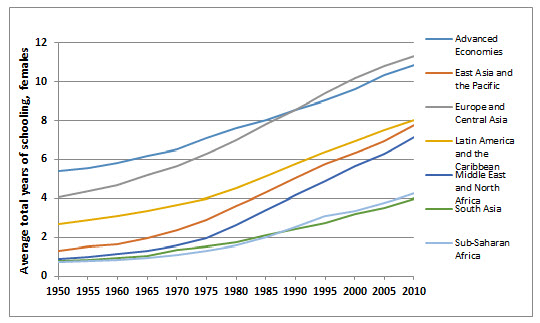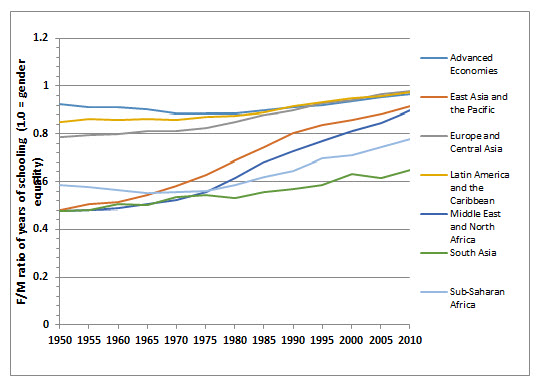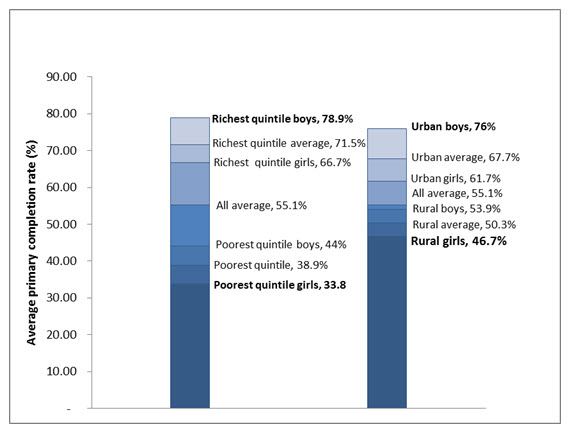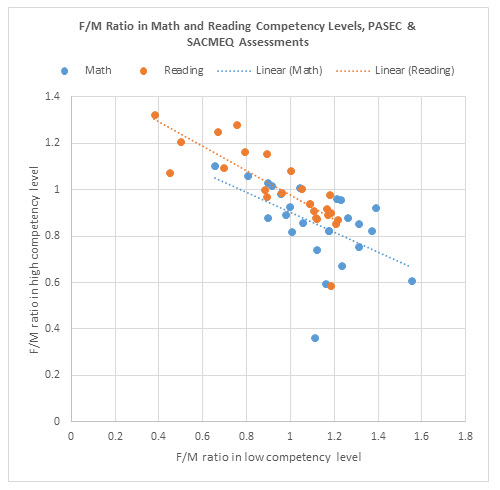There are now more girls attending school in the developing world than ever before, and the gender gap in education has narrowed considerably. But hold the celebration. Despite the progress indicated by the Millennium Development Goal (MDG) statistics, there are some countries where gender equality in education is still far from being reached. And unless progress is accelerated in those countries, the global goals for education will not be met (figure 1).
Figure 1. Average total years of schooling, ages 25 and above


Source: Barro R. & J.W. Lee – v. 2.0, 06/14.
In a June 2015 paper, my coauthor and I distinguished among three different types of gender education inequality that exist across countries, poor and rich alike. There are:
- Countries that are far from reaching even the fundamental goals of increasing girls’ participation in basic education and achieving gender equality in completion rates (the MDG 3 goals);
- Countries that have made notable progress in participation and completion numbers but still struggle to improve learning outcomes; and
- Countries that have expanded education access and completion and raised learning levels, but show significant gender differences in the mastery of language and math skills.
Several of the world’s poorest countries belong to the first group, showing little progress despite the technical and financial support of international development agencies such as UNESCO and the World Bank. In Afghanistan, Chad, Togo, the Central African Republic, and Mali, to name a few, girls’ net enrollment rates at the secondary level are about one-half or less of boys’ rates. This situation warrants the best that development knowledge, experience and resources have to offer.
The anatomy of gender inequality in education
Large gender gaps in basic education translate into sizable disparities in the education of the adult population. For women, little or no schooling can mean a lifetime of not being able to access the information they need to make important life decisions or to protect themselves from harm or destitution. In other countries, where average education numbers look better, there are girls who fare as poorly as those in the worst countries. These are girls who face multiple sources of disadvantage—income poverty, remote residence, disability, and minority ethno-linguistic background. According to household survey data from more than 50 countries, the ratio of rural girls’ primary completion rate is 0.87 to rural boys, 0.76 to urban girls, and 0.61 to urban boys (figure 2). Adding ethnic and linguistic disadvantage paints a more dismal picture. In Bolivia, for example, although the gender gap in years of schooling among the non-indigenous population has disappeared, among the indigenous population that makes up about 40 percent of the total population, rural indigenous women have the least schooling—a total difference of about seven years at age 18.
Figure 2. Average completion rates in primary education, by gender, income group and rural-urban residence

Source: Authors’ calculation using latest available data from Demographic and Health Surveys 2000-2011. Note: Aggregates for low-income countries are averages of 24 low-income countries for wealth disaggregates and for urban/rural disaggregates weighted by primary school age population.
Learning matters
Gender differences in enrollment and completion rates do not give the full picture of gender equality, but comparable measures of the quality of learning opportunities available to girls globally are not available. For now, consider the scores on international or regional standardized tests as a measure of the quality of learning opportunities. These scores are the product of the quality of classroom instruction and the school environment, as well as the level of support for learning in the home, and individual characteristics.
Fewer than 80 countries have data on student achievement, as measured by student performance on international standardized assessments (such as PISA, TIMSS, and PIRLS). There are countries that participate also or only in regional standardized assessments (including SACMEQ for anglophone African countries, PASEC for francophone African countries, and LLECE for Latin American countries), allowing cross-country comparisons within regions. Unfortunately, most countries in Asia and the Middle East do not participate in international or regional assessments. Because the tests are given at different ages or grades, comparing scores across the tests is not straightforward. Instead, for each test, we can compare the ratio of girls to boys who perform at the highest competency level with the ratio of girls to boys who perform at the lowest competency level.
The gender ratios at the highest and lowest competency levels reveal that, in general, girls are better than boys in reading but worse than boys in math. Media articles have already remarked on this pattern as a common one that emerges even in rich countries. Focusing just on African countries using the SACMEQ and PASEC data, we see a similar pattern: In math girls are overrepresented in the low competency levels relative to boys and under-represented in the high achievement levels. In reading comprehension, girls are underrepresented in the low achievement levels and equally represented or overrepresented in the high achievement levels. Note, however, that until assessments of the fundamental skills of reading and math are fielded outside schools in order to test also those girls who are not in school, we won’t have an accurate picture of the skills-deficit that girls carry into adulthood.
Figure 3. Female-male ratios in math and reading competency levels, African countries, latest year

The gender pattern in math and reading scores has been the subject of numerous studies that examine a range of factors: Does it stem from natural differences in biological abilities? Is it due to prejudice in the classroom? Is it due to social attitudes toward girls and women in the home and community? Of note is that this gender pattern in competencies foreshadow the fields of study that young men and women later choose at higher education levels and the type of work they have as adults. Glass ceilings in the workplace and other areas of society start with glass ceilings in schooling.
Closing gender gaps in education
Numerous research studies and development projects point to four sets of obstacles to improving girls’ education, especially in low-income countries and disadvantaged contexts:
- Direct and indirect costs of schooling are higher for girls than boys. Most countries do not charge tuition fees in public primary schools, and some countries have eliminated such fees even at the lower secondary level. Nonetheless, there are other direct costs that can discourage school attendance—and when social taboos dictate gender-specific costs (e.g. special transportation or a chaperone for daughters to and from school), when the supply of school differs by gender (e.g., girls are allowed only in single-sex schools or classrooms), or when the opportunity cost of children’s time varies by gender (e.g., daughters do more total hours of work than sons), the total cost of schooling for girls may be large enough to deter their attendance. In addition, when schools fail to stimulate interest in learning or make it worthwhile, students may decide to spend their time elsewhere or are not motivated to attend classes daily. In these cases, compulsory education laws and zero-fees will be more successful in raising enrollment rates if they are combined with actions to compensate families for the other costs associated with schooling.
- The restricted space and expectations embodied in social norms and attitudes limit girls’ ability to reap the returns to education. Social norms define the roles that women and men have in the family and the community, their individual preferences and the kind of relationships they form; behaviors outside the accepted social boundaries can unleash formal and informal systems of social sanction. In all, the degree of autonomy and empowerment that girls and women possess shapes how much they can gain from schooling. Parents and students try to see into the future and form expectations about how education will improve their lives. Where education can open up possibilities of a better life, it will garner more time and resources from the family. For boys, this would mean being able to find a well-paying job and a good marriage; for girls, the same may be true but not probably in equal measure. In West Bengal, in homes where no woman had ever been the local leader, 86 percent of parents want their daughters to be either a housewife or whatever their in-laws would decide for her. Twice as many parents want their teenage sons to graduate from secondary school or college as those who wished the same for their daughters.
- The pressure to marry and start a family early keeps girls out of school—and in some countries, schooling may hurt a girl’s chance to marry well. According to UNFPA, “one in three girls in low and middle-income countries (excluding China) will marry before the age of 18. One in nine girls will marry before their 15th birthday.” Most countries have laws in place to address this practice, but customary law and inadequate implementation weaken such laws. In Niger, 76 percent of girls marry or are in a union by age 18 and 28 percent by 15. The countries with the highest prevalence of child marriage are concentrated in Western and sub-Saharan Africa; due to population size, however, the largest number of child brides reside in South Asia (UNICEF, 2014). Child marriage imposes heavy costs for girls socially, physically, and emotionally. Particularly for girls below the age of 12, arranged marriages typically involve marrying much older men. Such a large age gap can make it difficult for girls to assert their rights, including about their sexual and reproductive health. Early pregnancy is consistently among the leading causes of death of girls aged 15-19 worldwide. In sub-Saharan Africa, a woman faces a 1 in 31 chance of dying from complications due to pregnancy or childbirth, compared with an average risk of 1 in 4,300 in developed countries; girls younger than 15 face worse odds. The practice of child marriage undermines the well-being of girls and women.
- School-related violence harms millions of girls and young women and makes schools a risky place for them. Incidents of school violence have become more public through social media. The violence includes extreme acts such as kidnapping, bombing, maiming, and killing, which often occur in contexts of armed conflict, as well as often unreported (and thus invisible) cases of sexual abuse, exploitation, and bullying. One study of 19 countries surveyed more than 100,000 male and female students to examine the prevalence of bullying in schools. It found that the prevalence of bullying ranged from less than 20 percent in Tajikistan, to 20-40 percent in China, Lebanon, Morocco, Oman, the Philippines, the United Arab Emirates, Tanzania, and Venezuela, and to 41-61 percent in Botswana, Chile, Guyana, Jordan, Kenya, Namibia, Swaziland, Uganda, Zambia, and Zimbabwe. On average, boys are bullied more frequently than girls but the difference is small (36 percent compared with 33 percent). Another survey obtained data about the abuse of girls by male teachers; in middle schools in Ghana, Malawi, and Zimbabwe, this abuse was part of a broader school-based violence which included also the excessive use of corporal punishment and bullying. The effect of school-based violence on academic performance and attendance is typically not examined in research on the determinants of schooling, but this problem is more common and more insidious than we recognize.
Compulsory education laws, the abolition of tuition fees, and support for other costs through scholarships and cash transfers to families have had positive effects on girls’ enrollment and completion rates, but these interventions address mainly the first set of obstacles. To remove the barriers and achieve greater progress in the countries with the worst record in girls’ education, the other obstacles must be addressed too. Other reforms are needed: ensuring that learning happens in order to increase the social and economic returns to education, addressing gender bias in the formal and hidden curricula, and making schools welcome and safe places for girls and boys. Reforms outside the school system are needed too—enacting laws or enforcing existing ones about the minimum age of marriage and addressing gender bias in the workplace. Gender gaps in education reflect, in large part, gender bias in other parts of society and the economy.
Taking action
A convergence of positive forces accounts, at least in part, for the global progress in girls’ participation and completion rates even in low-income countries. This convergence is worthy of celebration and one we can build on—the emergence and consolidation of political and programmatic support for gender equality in education by civil society, national governments, the media, private sector, and international development organizations. In the last quarter century, grassroots-level action has amplified into national policy debates, donor strategies, media campaigns, multilateral action, and initiatives of increasingly high-profile global advocates.
Education as a sector now has many rigorous evaluations, as evidenced by several recent excellent reviews of education programs (for example, for programs in African countries, see Conn 2014; and Kremer, Brannen, and Glennerster 2012). However, these evaluations do not often disaggregate results by gender. It is important to consider female-targeted programs—those policies that alter the costs or benefits of girls’ schooling relative to boys’ schooling—as well as supposedly gender-neutral interventions, which do not specifically target female (or male) schooling returns or costs but may have gender-differential effects. Policies to improve girls’ education in developing countries have generally focused on increasing the immediate benefits of schooling as well as on reducing the costs of attending school for girls. Policies not directly concerned with education, labor market, and childcare services (such as those providing cash transfers to households), have also been shown to affect schooling incentives and may do so differently for girls and boys.
I also want to highlight here two actions that our paper ends with. The first action we recommend is supporting girls’ and women’s leadership using specific initiatives that are well positioned for engaging diverse actors, including women’s groups, technology companies, media partners, transparency and education NGOs, and government education planning departments. A few examples of these initiatives would be to support women’s groups to monitor the gender impact of education programs and lead efforts to improve gender-specific data in education. These initiatives are envisioned as catalytic “quick wins” that, if given sufficient financial and political support, could bring about sustainable social change not only for girls’ educational opportunities but for gender equality more broadly.
The second action is to pursue systemic reform with gender in mind. Ultimately, the best approach to rooting out entrenched gender biases in education is to ensure that countries have strong education systems, ones that enable all children to have good schools and learning opportunities. Good schools must be places where girls and boys alike must be given the opportunity to thrive and grow. This means a school environment that is respectful and free of violence; teachers are motivated, trained to teach, and gender-fair; infrastructure is adequate and equally accessible to boys and girls; textbooks and other materials are relevant, gender-sensitive, present, and used; all students spend their time in school engaged in learning activities; and support to families that is informed by issues related to gender equality. A reform approach mindful of these gender issues has long been recognized as important, but it needs renewed commitment for implementation in all countries.


Commentary
Op-edHold the celebration for girls’ education
November 3, 2015